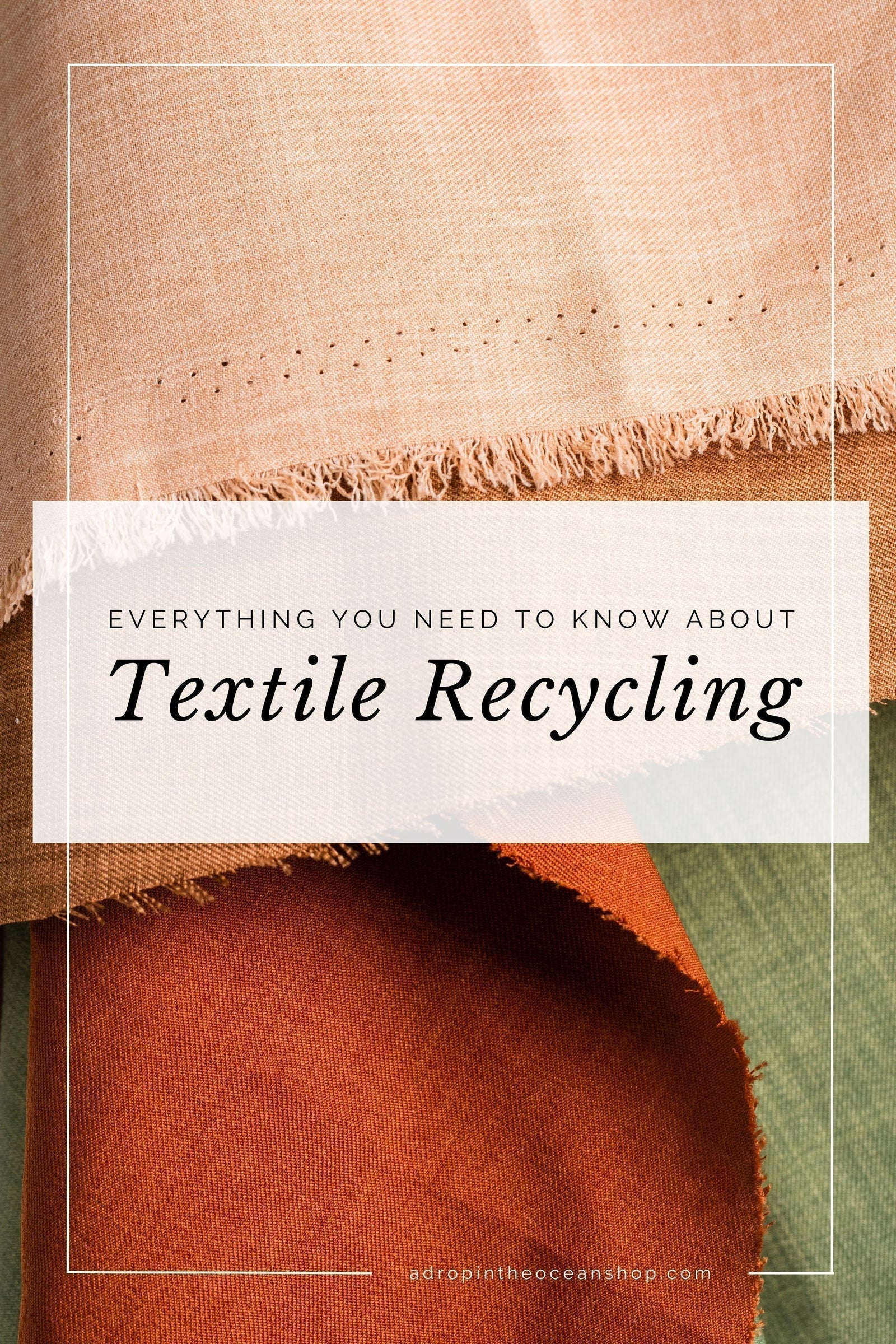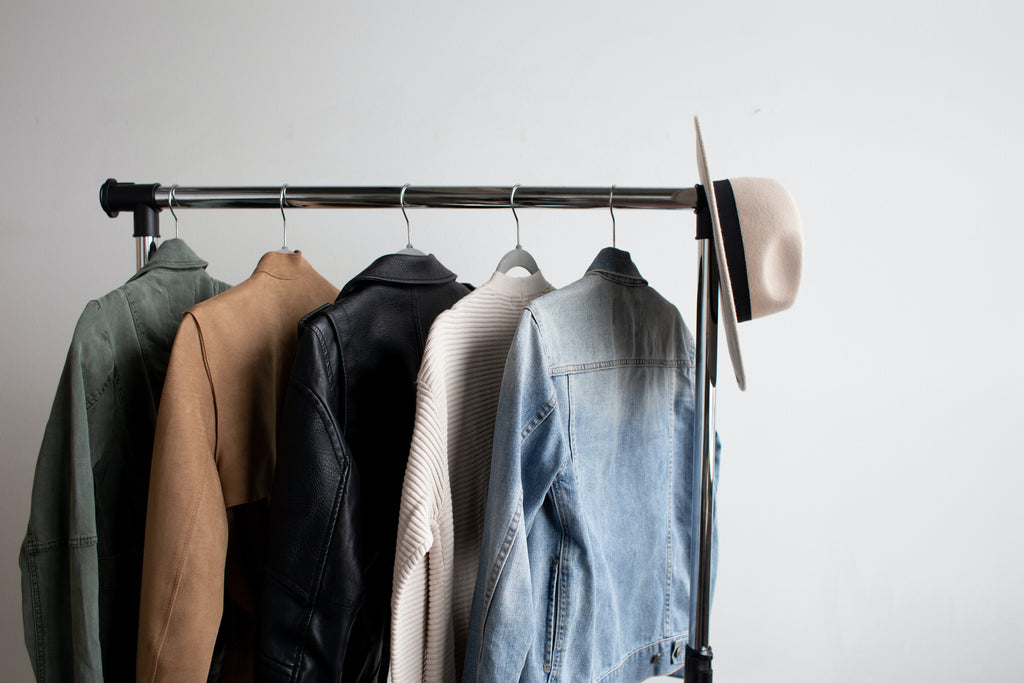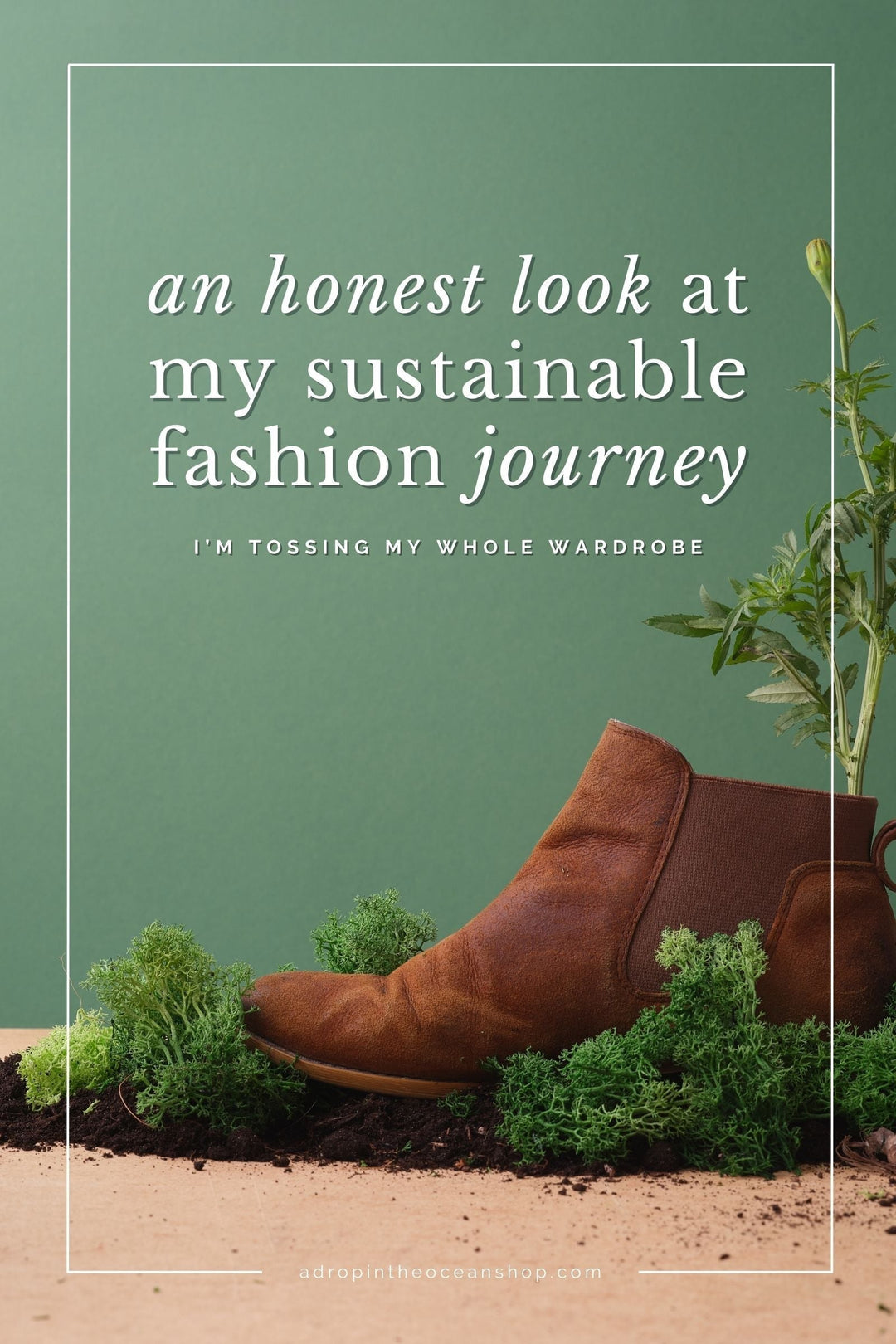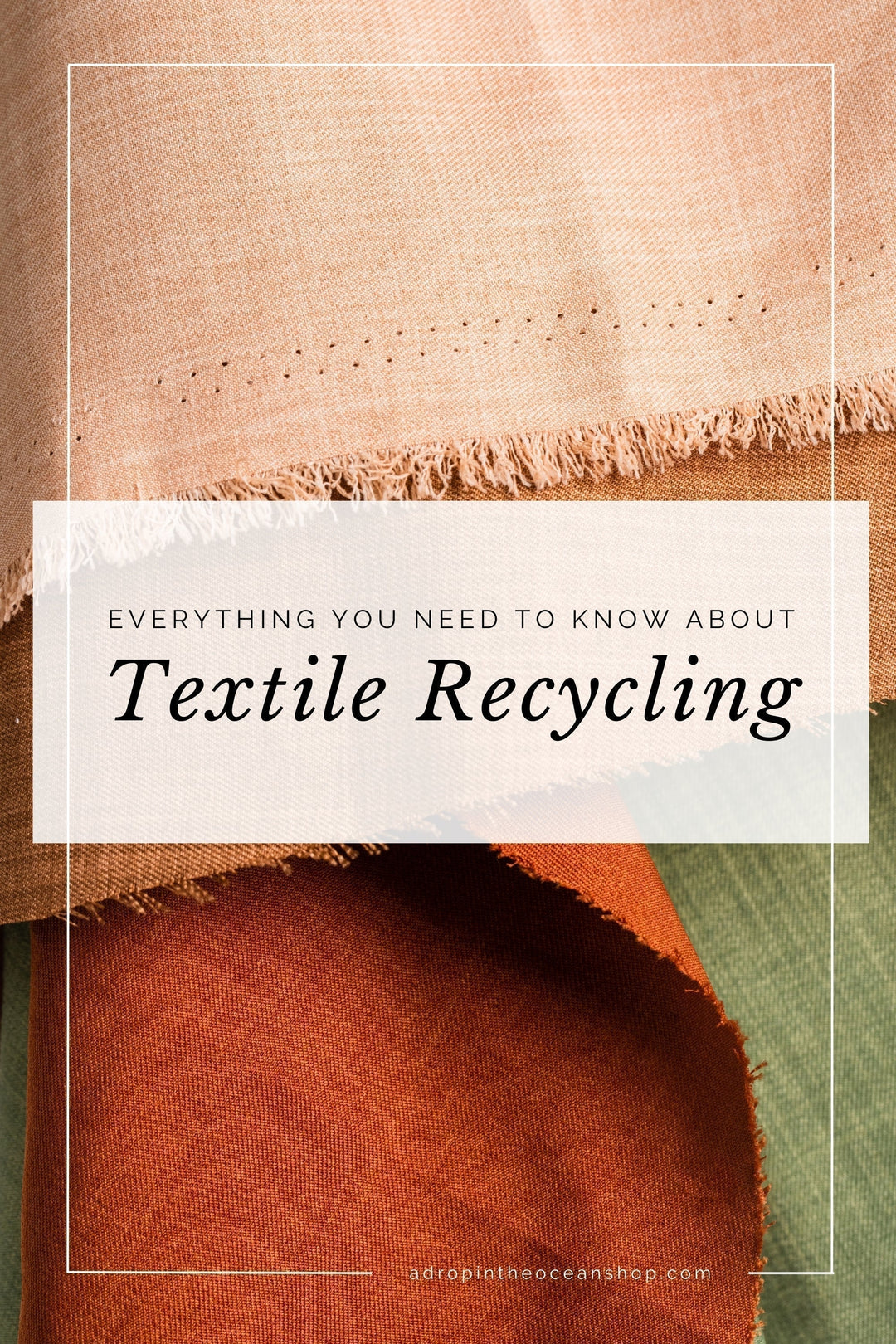Is textile recycling greenwashing or an actual waste solution? Here's everything you need to know.

Okay, friend. I’ve been on my zero waste journey for nearly 9 years now, and throughout that time, as I’ve shared about my journey and experiences, I have received countless questions about what to do with old, worn out clothes.
And, honestly, my answer has pretty much always been somewhere along the lines of “throw them in the trash can.”
I still stand by that response, for reasons we’ll get to shortly, but…are there better options?
Does true textile and clothing recycling exist? Or are we all out here being bamboozled by companies trying to exploit our desire to do good?
👆 This is the question I’m on a mission to answer today.
I have really high standards. I’ve been told that my whole life. For my friends, my coworkers, my employers, my business, my product vendors, myself.
And that has 100% bled into my views on ~a lot~ of “sustainable” businesses and products.
I’ve called many of them out in the past… Blueland, Boxed Water, Terracycle and Ridwell, and even other zero waste shops (multiple times)…
And textile recycling is no different.
None of the options I have found truly live up to my standards, which is why I’ve never written a post like this in the past.
And why my go-to answer for what to do with worn-out clothes has always been “trash it.”
But maybe there’s some grey area?
I mean, a quick Google search for “textile recycling” will get you a boatload of listicle-style blog posts from some of the top zero waste bloggers with a plethora of suggestions for where to send your unwanted clothes.
But none of them really, truly address the fundamentals.
What exactly IS textile recycling?
What happens to your clothes once they’re sent off in a take back bag?
Does textile recycling really reduce demand for new fibers, or are we just perpetuating a broken and exploitative system?
Today, we’re gonna dive into all of these questions and everything else you could ever possibly want to know about textile recycling, the environmental impact of our clothing, and what to look out for so you can outsmart the ever-rampant greenwashing scams.
It’s gonna be a heck of a journey together, but I honestly can’t wait to get started.
So if you’re ready, friend, let’s dive in.

Why language matters for true sustainability.
A few years ago I wrote a whole blog post laying out 22 of the most common sustainability buzzwords and what they actually mean. If you haven’t read it yet, I definitely recommend taking a peek!
I fully believe that before we can even start to talk about textile recycling, we need to first have a conversation about the word “recycling.”
When we hear the word “recycling,” we often imagine a clean, green system where Item A is recycled back into another Item A.
An aluminum can is recycled back into another aluminum can.
A plastic water bottle is recycled back into another plastic water bottle.
A cotton sweater is recycled back into another cotton sweater.
But in reality, only one of those three statements is actually true.
✅ That aluminum can will be recycled back into another aluminum can.
❌ But that water bottle is going to be “recycled” into something like a park bench, or maybe even a sweater.
❌ And that sweater is going to be “recycled” into something like mattress stuffing.
It’s important to understand how we are using the term “recycling.” Because it, unfortunately, can mean so many different things.
There are actually two different types of recycling — open-loop recycling and closed-loop recycling.
Closed-loop recycling is what we aim for. That aluminum can turning into a new aluminum can is a perfect example of closed-loop recycling. It’s a system that closes the loop on resources, and actively reduces demand for new, virgin resources.
Open-loop recycling is where we’re currently at in most cases. That water bottle turning into a sweater or that sweater turning into mattress stuffing are examples of open-loop recycling. This type of recycling takes one item or material and turns into a different item or material. It’s a handy solution for keeping resources out of our landfills, but it doesn’t really reduce the demand for new, virgin resources. (aka We’re going to need to produce new plastic bottles to replace the ones we recycled into a sweater.)
This is why we can’t just take “recycling” at face-value.
We need to understand what is actually happening to the things we’re sending to recycling.
🔄️ Are they being closed-loop recycled and reducing demand for virgin resources?
↩️ Or are they being open-loop recycled (aka downcycled) and essentially maintaining status quo?
We will explore these questions throughout today’s blog.
Now, first things first…
Let’s talk about the impact of textiles and textile waste.
Here’s the thing about our clothes…
They are one of the top polluting industries on the planet — and the fastest growing (source).
The textile industry is responsible for about 10% of all global carbon emissions each year, making it the fifth highest greenhouse gas emitter on the planet (source).
💡 A textile is any type of cloth or woven fabric.
According to The Ellen MacArthur Foundation, in 2015, textile production alone across the world emitted a whopping 1.2 billion tons of carbon dioxide equivalent (CO2e).
💡 CO2 equivalent (CO2e) is the standard unit of measure for carbon footprints. It takes all the greenhouse gas emissions and standardizes them to carbon dioxide emissions, rather than breaking them out into carbon dioxide, methane, etc.
Now. I know we hear a lot in the zero waste and sustainable living communities about the massive impact air travel has on our planet, but that 1.2 billion tons of CO2e that’s emitted from making our clothes in one year is actually more than ALL annual international flights and maritime shipping combined (source).
Yes…really.
And if we continue on this current trajectory, textile production could use more than a quarter of our carbon budget for a 2°C global temperature increase limit by 2050 (source). I mean seriously, imagine what we could do for climate change if we made some substantial changes just to the way to produce, consume, and dispose of our clothes 😳
But. These are really big numbers. And I dunno about you, but sometimes those really big numbers can be a lot to wrap my head around.
So let’s scale this back a bit…
According to a 2014 study from the Journal of Textile Science & Engineering, to produce and transport just ONE cotton/polyester blend t-shirt requires:
- 2,400 gallons of fresh water
- 0.55 pounds of fertilizer
- 0.02 pounds of pesticides
- 2.2 pounds of fossil fuels
- 16.3 pounds of carbon dioxide emissions
- 0.28 pounds of other greenhouse gas emissions
But where is all of that coming from, exactly?
Well, we gotta grow the cotton, turn it into threads, dye the threads, turn the threads into a t-shirt, then ship that t-shirt across the country (or, more likely, the globe), put it on a shelf, and then bring it home with us after we purchase it.
And that polyester piece? Did you know that 52-64% of all textiles are made from polyester — aka plastic, aka non-renewable fossil fuels (source, source, source)?
We’re not just growing cotton and turning it into fabrics and t-shirts anymore.
We’re extracting fossil fuels from the earth and using those fossil fuels to create cheap polyester fabrics intended to be worn just a handful of times before we toss them aside for the next hot trend in fashion.
This is what we call fast fashion, my friend.
According to that same study by The Ellen MacArthur Foundation, clothing sales have more than doubled just since 2000, but the number of times an item of clothing is worn has decreased by about 36%.
Even worse, apparently here in the US, we only wear clothes for about a quarter of the global average.
So if that cotton/polyester blend t-shirt is worn, on a global average, 40 times before it’s thrown away, that same t-shirt is only gonna be worn about 10 times in the US before it’s tossed.
Especially in a time when so many people are struggling to pay their basic bills, I think it’s also worth noting that all of this perfectly usable, tossed clothing adds up to $460 billion in lost value (source).
We’re literally throwing away billions of dollars in usable resources — plus the time and energy spent to make those clothes in the first place.
And we’re not just wasting the money we spent buying the clothes.
More than half of all fast fashion items that are produced are thrown into a garbage can less than one year later (source). It’s the equivalent of one full garbage truck-worth of textiles being thrown into a landfill or incinerated…every single second.
Those textiles don’t just magically end up in a landfill or in an incinerator though.
New York City alone spends an astonishing $20 million every single year just on landfilling and incinerating textiles (mostly clothing items) (source). NYC might be a big place, but every city is going to have these same kinds of problems.
And all of that $20 million is coming from tax dollars.
Our tax dollars.
We are spending uncanny amounts of money on our clothes every year, using 96 million tons of non-renewable resources to create them, and then spending even more money to literally burn it all to ash less than a year later (source).
~None of it~ makes actual, logical sense.
So let’s talk textile recycling.

What is textile recycling, really?
We’ve already discussed why language matters, and why we need to understand the various uses of the word “recycling,” and this is why 👇
As defined by a 2022 study, textile recycling is “Reprocessing pre-consumer and post-consumer textile waste for use in new textile or non-textile products.”
(It’s the ‘non-textile products’ part that gets me...)
Pre-consumer textile waste is textile waste that is produced before it ever reaches us (consumers). This is waste that’s created in the manufacturing process of items that are destined for our hands. For example, the pieces of fabric that are left over after a t-shirt is cut out.
Post-consumer textile waste is the textile waste that we create as consumers when we throw away (or recycle) clothing, towels, bed sheets, and other textiles we no longer want.
(There is also industrial textile waste, which is textile waste produced in commercial or industrial settings. TBH I imagine there’s overlap here with both pre-consumer and post-consumer textile waste, but this type of textile waste doesn’t come up in many studies, so I’m not sure exactly where that overlap lies.)
And, of course, it’s never as simple as a one-sentence definition 🙄
There are actually two different types of textile recycling:
There’s mechanical textile recycling, which involves physically breaking down or shredding textiles into their components (source, source), which often results in lower quality materials (source),
And there’s chemical textile recycling, which involves adding chemicals to the textiles to break down the polymers that make up the material (source).
The benefit of chemical textile recycling is that it typically results in the same quality materials as the virgin materials, but this technology isn’t yet widely available or ready for large-scale commercial use (source, source).
Because chemical textile recycling isn’t widely available yet, the most common uses for recycled textiles are mattress stuffing, insulation, and cleaning cloths…all of which is done through mechanical recycling and typically not recyclable again (source).
💡 Mechanical textile recycling is open-loop recycling, while chemical textile recycling is more of a closed-loop recycling system.
So what’s the problem with textile recycling, then?
Okay, friend, let’s get honest here.
We are producing and discarding clothes at an alarming rate. It’s affecting the planet, people, and our pockets.
And, we have technology that allows us to turn unwanted textiles into new materials.
So why isn’t textile recycling more widespread? Clearly we could use it…
Right now, according to that 2022 study, here in the United States, 85% of our textiles are going to landfill or being incinerated.
[Not-so-] fun fact: “Prior to WWII, the US was a major importer of rags, cuttings, and other textile waste materials because the US was a leader in mechanization for converting the used textiles into manufactured raw materials. The situation has been reversed since WWII. Now the US exports tons of textile waste materials, primarily because of the overconsumption of textile goods that eventually results in textile waste.” (source)
And while 15% is being reused, donated, or recycled, less than 1% of that is actually being closed-loop recycled into new clothing (source, source).
Some experts even suggest that that 1% number is actually closer to 0.1% for after-use clothing — or the clothing that we’ve already worn and discarded ourselves. (So really, the whole focus of today’s blog is on this after-use clothing — and just one-tenth of one percent of all that clothing is actually being turned into new clothing items 🤯)
Like I said, there’s currently no widespread technology available for closed-loop clothing recycling on a commercial scale.
And while we are likely to develop that technology within the next 15 years or so, it’ll likely only be for very specific, common types of textiles, such as 100% cotton or cotton/polyester blends (source).
So what are the challenges to developing and scaling this technology?
Well, for one, all of the different materials (for example, cotton and polyester) must be separated and recycled through different methods (source).
I dare you to take a look at the labels on three of your most-loved clothing items. How many different materials are listed on their tags?
Go ahead, I’ll wait.
But get this…
According to The Ellen MacArthur Foundation, “Even when clothing is labeled as 100% single material, it can still contain small quantities of other materials, and certain parts, such as labels or sewing threads, can be made from a different material. For example, polyester stitching threads are usually used because of their strength and durability, even if the rest of the garment is made from cotton.”
So yeah. Even if your favorite shirt’s tag says it’s 100% cotton, the threads holding it together may actually be polyester.
🧵 And I can tell you from experience making our [actually] 100% cotton reusable unpaper towels and reusable gift bags every year that the availability of polyester thread vastly outnumbers the availability of cotton thread.
It takes a lot of man-power to sort through textile waste to determine an item’s material composition.
So in order to expand and improve textile recycling, we also need to expand and improve technology that streamlines this process — accurately and reliably. And sustainably. (source)
Oh and did I mention that zippers and buttons, and even dyes and chemicals must also be removed from the textiles before they can be properly recycled??
We probably all already know that textile fibers lose their quality through use and washing, but they also lose quality through this rigorous process of disassembly, which means that right now, new, high-quality, virgin fibers must be added back into the process to improve the fibers’ durability so they can be remade into new textiles that can actually withstand any kind of use (source, source, source).
So even as we improve technology and access to textile recycling, some virgin fibers will likely always be needed (source).
It’s worth mentioning, too, that even with new technologies that allow us to create textiles from seemingly sustainable materials (think, pineapple leather, etc.), it can actually inhibit the growth of a closed-loop, circular economy because it creates a new waste stream (source).
That 2014 study from the Journal of Textile Science & Engineering said it best:
“Nonetheless, the recycling industry must cope with everything that the fashion industry has generated.”

An argument in favor of textile recycling…
So hopefully you can see now, friend, why my go-to suggestion for what to do with worn-out clothes has been to throw them away.
But let’s talk briefly about why we should be supporting textile recycling initiatives.
1️⃣ First and foremost…
The textile industry has long-documented poor working conditions, including long hours, low pay, and even modern slavery and child labor (source).
By first supporting slow fashion and ethical production, then wearing our clothes, sleeping on our sheets, and drying off with our towels as long as possible and only discarding them when they’re truly worn out — and then actually getting them into a true recycling system — we’re not letting the work of those individuals be for nothing.
I’d also like to reiterate that we want to first support ethical production in the textile and clothing industry.
The current working conditions running rampant in this space are not okay. Full stop. ✋
But if we already have items in our closet from a fast fashion brand, let’s make sure we’re respecting the time, energy, expertise, and effort that went into making it.
2️⃣ Second…
Every textile will, at some point, become worn out.
No matter how it’s made, what it’s made of, or how well it's taken care of, every single textile will wear out at some point.
Of course, there are things we can do to make them last longer — such as washing on cold, using a natural detergent, and hang-drying instead of tumble-drying — and we should absolutely be doing those things, but even the best-made items will reach the end of their life at some point.
And do we really want every textile ever made to just go to a landfill or end up in an incinerator?
I think probably not.
3️⃣ And third…
While a given textile may be worn out and no longer useful, it still contains roughly the same amount of matter and energy that went into its making. We should do what we can to return that matter and energy to another, useful product (source).
But before we can talk about some specific textile recycling programs, let’s have a quick chat about my favorite topic…
Greenwashing in the textile and textile recycling industry.
If you’ve been part of this EcoWarrior community for a while, you know by now that I can talk about greenwashing for daysssss.
💡 Greenwashing is when a company spends more time and more money making you think they’re doing something good for the planet than they spend actually doing something good for the planet.
And, unfortunately, as more and more of us are becoming aware of the problems associated with climate change and the importance of environmental sustainability, more and more companies are trying to bamboozle us with their greenwashing.
And they’re real dang sneaky about it, too.
Most of the time, they’ll even make us feel like it’s our fault, or that we should shoulder all of the responsibility of responsible disposal.
But it shouldn’t be all on us.
“Establishing a suitable system for textile recycling requires collaboration between clothing companies and stakeholders such as government, researchers, collectors and recycling companies.” (source)
We need everyone — top-down and bottom-up — doing their part.
But unfortunately, right now, most clothing design and production doesn’t consider what will happen to the clothes when they wear out and can’t be worn anymore (source).
Which leaves us with afterthought recycling systems, trying to clean up the mess of the ones producing the clothes.
Sometimes they’re legit.
Most times they’re bullsh*t.
Here are some things to look out for when it comes to greenwashing in textile recycling programs:
🚩 What is their end goal? Are they ultimately just trying to get you to buy more of their clothes?
H&M’s textile recycling program is a primo example of greenwashing here. H&M incentivizes its customers to bring in their unwanted clothes and drop them in a recycling bin in-store by offering a discount on their next H&M purchase.
On the surface, this sounds great, but in reality, the end goal here by H&M is to simply get you to buy more of their [fast fashion] clothing, thus perpetuating the endless cycle.
H&M has partnered with a textile recycling company to actually recycle some of its garments, but, like we established earlier, the tech can’t keep up with demand.
Not even close.
It would take the machine 50,000 years to deal with just one week’s worth of discarded clothing.
And H&M admits that they plan to keep growing.
H&M’s former CEO and current chairman has even gone on record saying, “There’s no question that we’re producing more garments than people buy, people are buying more than they really need, and the planet can’t cope. I think the solution is not to stop consuming, but to preserve jobs.”
So H&M recognizes they’re the problem, but won’t actually do anything about it.
And, my personal favorite… The CEO of the textile recycling company even said, “My nightmare scenario in the industry is that we’re satisfied with modest goals, and that doesn’t do anything for anybody. And we’ll be accused of greenwashing, and by and large, that will be true.”
🚩 What do they do with the textiles? Do they have a clear outline for what happens after they receive the clothes for recycling?
Historically, a large majority of the clothing we donate or send for recycling never actually makes it to the resale shelves or a recycling center.
Instead, they’re baled up and shipped off to various African countries where they’re sold for cheap. And in recent years, many, if not most, of these countries have said “no more!” and implemented bans on these textile imports. Because, why wouldn’t they??
But it’s still happening.
Ridwell is a local specialty recycling service in the PNW and a few other areas around the US, and they do offer textile recycling pickup in their services.
But when you look a bit deeper into this program, it’s not actually doing much, if any, true textile recycling.
In the region I live in, Ridwell partners with “Rag Mine Clothing” for their textile recycling.
(The first time we shared this blog back in October 2023, they were called “Rag Mine Clothing Recycle,” and their LLC is still registered as such, but apparently at some point in the last two years they changed their public-facing name.)
Right on the homepage of Rag Mine Clothing’s website they actually brag that “you can rest assured your used clothing and textile donations will go to developing countries…” 🙄
And on their FAQ page, they say there are four different avenues your donated clothing can go:
-
A portion are sold by Rag Mine Clothing.
-
A portion are sorted for quality and sold to international buyers.
-
A portion are sold / donated to a clothing exporter who ships to numerous countries in Africa.
-
A portion are sold to small-scale local merchants and artisans to be sold, reused, and repurposed at local markets.
So, quite literally, Rag Mine Clothing Recycle LLC is doing ~zero~ clothing recycling.
This 👏 is 👏 why 👏 language 👏 matters. 👏
This company has literally infused greenwashing into the name of their company.
But unless you’re someone like me who has a deep distrust of recycling companies and wants to know specifically where your stuff is going, you’d probably just look at Ridwell’s website, get excited that they accept textiles, sign up to pay them $14 a month, and call it a good day.
But in reality, you’d be paying one middleman to make more money by selling your clothes to ANOTHER middleman, who will in turn sell your clothes again to YET ANOTHER MIDDLEMAN who will then sell your clothes AGAIN in markets that don’t even want your clothes.
You can see why I have such distrust for any company that claims to be “sustainable.”
Also, please note here that they’re not sending the top-quality clothes to these African countries. They’re making top-dollar on those things here in the States and then sending the “leftovers” overseas in bales. Like somehow these communities are less deserving of quality clothing than we are? And these countries often don’t have the infrastructure to deal with these low-quality, truly waste textiles, so they end up piling up, adding pollutants to the environment, and posing health risks to the communities. It’s all bad all around and needs to stop. Like, now. /endrant

So are there any textile recycling companies that hold up to The Krystina Standard™?
(Not actually trademarked, but maybe it should be 😅)
So now that we’ve thoroughly covered all the nitty gritty of textile recycling as a system, let’s actually look at some of the post-consumer textile recycling companies I’ve found and whether or not they hold up my standards.
Trashie
a.k.a. For Days
Once upon a time (in 2018), there was a slow, circular fashion brand called For Days. They sold 100% cotton t-shirts, right down to the treads and tags, printed with water-soluble ink. And they infused circularity into their business model from the get-go — buy their sustainably-made t-shirt, wear it until you can’t wear it no more, return it back to them, and they’ll recycle it back into a brand new 100% cotton t-shirt.
But in recent years, For Days has completely shifted gears and are now the parent company of Trashie and its Take Back Bags, the brightly-colored plastic bags advertised all over social media as The Solution to our clothing waste problem.
As of 2023, For Days no longer makes their own products, focusing all of their efforts on selling more Take Back Bags and then offering you “Trashie Cash” in return for buying a Take Back Bag, that can be used at the ~most sustainable~ and ethical brands out there, like Walmart and DoorDash. (heavy sarcasm there if you couldn’t tell…)
The whole thing is super offputting, but here’s what you gotta know about their recycling system nonetheless:
What they accept: Any unwanted clothing, shoes, bags, accessories, and linens in any condition, including ripped, torn, or stained.
What happens to the collected items: Now that’s the question isn’t it…
When we first published this blog post back in October 2023, the For Days website said that 50% of the donated items are downcycled into things like insulation and rags, while 45% are resold, and at least some percentage of those resold items are sent overseas. According to the website at that time, “Take Back Bag items that can be resold are sent to resale partners that service lower income communities. What this looks like: farmers in other countries accessing low-cost items to cover themselves against the sun.”
Today, there’s even less transparency.
On their FAQ page, the answer to the question, “Who is your recycling partner?” is a long-winded paragraph of nothingness.

On their “How We Recycle" page (still full of long-winded nothingness), one of their headlines is “Transparency,” about which they say, “We are committed to building trust through clear, accountable processes. Our best-in-class data system tracks every item, providing real-time sorting and grading reports and following each grade to its next life — whether reuse, resale, or recycling.” But when you try to find ANY information about that “best-in-class” data system or any sort of annual report, none exists.
Cost: $20. Theoretically, you receive 30 “Trashie Credits” in return, but all the reviews I’ve read have said that you basically can’t use your credits at all.
Learn More: trashie.io
Does it pass The Krystina Standard™? 😂😂😂 lol absolutely not.
Subset
Subset (formerly Knickey) is a sustainable innerwear brand, offering men and women’s underwear and loungewear made from only organic cotton.
When we first published this blog post, Subset had their own recycling program for underwear, bras, socks, tights, and cloth face masks, that was actually explicit in stating that none of the items sent to them would be sent to overseas markets. They were clear in their process and their values, and I appreciated the way they seemed to do things.
Unfortunately, Subset has now partnered with Trashie for their recycling program 👎
Retold Recycling
Similar to Trashie, Retold is exclusively a textile recycling company. They offer bags either on their own or in bundles or as a subscription so you can load up the bags and send them your unwanted clothes and textiles for resell or recycling.
What they accept: All clean and dry household textiles and clothes, in any condition, including underwear and laundered cloth diapers. They do not accept worn out shoes for recycling, but new, lightweight shoes without heels or sharp hardware that they can resell are accepted.
They have also recently introduced a Fabric Scraps bag that accepts leftover fabric scraps, sewing threads, and yarn.
What happens to the collected items: According to the Retold website, items sent to them are sorted and sent to thrift stores, charity stores, recycling companies, or downcycled into things like insulation and rags. It is unclear what percentage of items goes where. I did reach out to Retold when we first published this blog post to ask if they or any of their partners send items overseas, and I received the following response:
“Our current workflow is that all of our items go to a domestic recycling partner. A large portion of our bags are cleared to thrift stores and then the rest is sold to recyclers. The nature of our post-consumer items make them uninteresting to off shore processors, however unbeknownst to us, some small percentage of our bags may end up offshore fueling microeconomies / small marketplaces, etc.”
Cost: $15.50 for one bag, plus additional pricing options for multiple bags or subscriptions.
(If you use this link, you can save 10% on your first order. It is an affiliate link, so I will also get 10% off an order, but really I’m just trying to help you save some money!)
Learn more: RetoldRecycling.com
Does it pass The Krystina Standard™? It holds up enough that I’ll be using Retold for my textile recycling needs very soon. (Next week’s blog post will be all about my current sustainable fashion journey — including recycling!)
Blue Jeans Go Green
The Blue Jeans Go Green program is hosted in collaboration with Cotton (ya know, the “fabric of our lives” commercial people) and Zappos. They accept all types of denim, as long as they’re made with at least 90% cotton.
What they accept: All types of denim made from at least 90% cotton, including printed, colored, embellished, ripped, or stained denim or denim scraps.
What happens to the collected items: According to the Blue Jeans Go Green website, donated denim is downcycled into things like insulation, pet bed inserts, and mattresses. It is unclear what they do with denim they receive that is still in good condition (i.e. do they still downcycle it or do they first try to resell it?)
Cost: Free
Learn more: BlueJeansGoGreen.org
Does it pass The Krystina Standard™? Because this program is so specific in what it accepts, and clear in the things the denim is downcycled into, I have more faith in this one than most. If and when I end up with denim that’s too worn out to be donated, this is where I’ll go first.
TerraCycle Fabrics and Clothing Zero Waste Box
You probably already know my thoughts on TerraCycle, but just in case you don’t, I wanted this list to be inclusive of all your fabric recycling options.
What they accept: According to the TerraCycle website, clothing, fabric, and textiles are accepted in the Fabrics and Clothing Zero Waste Box. But omg could they be any more vague??
From another website that sells these boxes, you can include bibs, burp cloths, blankets, breast pads, changing pads, diaper bags, pillows, bedsheets, linens, play mats, play rugs, privacy wraps, mattress protectors, jeans, denim bags and accessories, canvas bags, mail bags, canvas tents, shirts, sweaters, tees, shorts, skirts, pants, socks, under garments, active wear, sleepwear, rainwear, hoodies, jackets, towels, non-plastic bath mats, bedding, window treatments, outdoor fabric from patio furniture, outdoor fabric mats, and other similar fabrics.
What happens to the collected items: I couldn’t tell you. There’s zero information that I can find about what happens to the items sent to TerraCycle in this box.
Cost: $149–379 (no, that’s not a typo)
Learn more: TerraCycle.com
Does it pass The Krystina Standard™? 😂😂😂 lol absolutely not.
In summary…
Holy moly, friend, that was a lot.
I mean, I knew I had a lot of thoughts on textile recycling but I had no idea I had 15+ pages-worth of research-backed thoughts to share 😳
But having said that, I really do hope that this information is helpful for you. Especially since in all of this research I didn’t find any blog posts or articles like this, outlining the good, the bad, and everything in between of textile recycling.
When I started writing this, I said I wanted to answer the question “Does true textile and clothing recycling exist? Or are we all out here being bamboozled by companies trying to exploit our desire to do good?”
And I think the answer is yes…and yes.
I think there are some companies that are trying to actually do right by us and the planet. But, unfortunately, I think there are FAR too few of them, and far too many that are trying to bamboozle us.
I do hope that over time we see a shift towards true circular, closed-loop, post-consumer textile waste recycling, and I hope we see that shift sooner rather than later.
But in the meantime, I hope this list of textile recyclers that at least pass the The Krystina Standard™ gives you a starting point. A resource for how to sustainably discard those worn-out, stretched-out, holey clothes, sheets, and towels taking up space in your closet without just saying “throw ‘em away.”
And remember - the better we care and maintain our clothes, the longer they'll last us and stay out of landfills or incinerators! So be sure to check out our top 10 tips for sustainable laundry care next.
And with that, I’m gonna give you your evening back — ‘cause this has been a doozy of a blog post and I’m tired 😅
Have an awesome week, friend, and I’ll “see” you again next week 💙









I’m interested in what you think about the brand Apparel Impact. Loved this article.
Absolutely excellent article! 👏 So well researched and well written! Thank you for your hard work and time.
On a personal note, I’ve been searching everywhere for bulk recycled, 100% wool, cotton, and other natural fiber clothing for all my sewing/ design projects. To say it’s been difficult is an understatement! Of course, I purchase locally at yard sales, resale shops wherever possible but it gets tedious and time consuming (and expensive). If you could provide information to help, I’d be thrilled and thankful!
Again, thank you for your informative article! 😊
@Lena – Not a silly question at all! And unfortunately, no, there’s nothing preventing that at this time 😖
I also recently saw a Trashie ad on Instagram and while Trashie was responding to every comment on the ad that was praising them (“This is awesome!”, etc.), every single comment asking what happens to the textiles once they’re sent to Trashie went unanswered.
Every. Single. One.
🚩🚩🚩
Thanks for the information It’s really good and easy to read and accurate information also.
Thank you! Really appreciate the time and effort spend.
Leave a comment